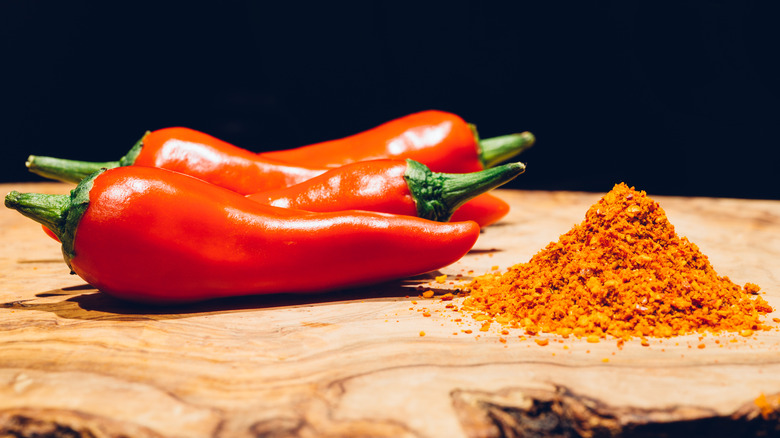Eggs Pipérade: The Veggie-Infused Basque Eggs You Should Know
You've probably seen eggs served with tomatoes and peppers before. Shakshuka, or as some call it, "eggs in hell," may come to mind: gooey eggs submerged into a stewed, cumin-and-tomato sauce served with a crusty baguette for dipping. Or perhaps you think of Chinese tomato egg stir fry, the easy egg scramble that comes together so effortlessly while hitting all of the requirements of a satisfying meal. After all, there is something quite delectable about combining the hearty, acidic flavor of stewed tomato with the egg, arguably the foundation of all cooking. Well, what you see in the image above is eggs pipérade, a dish that further confirms this match made in heaven.
If you want to impress your friends the next time you host a brunch, eggs pipérade is the way to do it. What is there not to love when you combine a sophisticated French name, slightly spiced tomato stew, and eggs, poached or scrambled in tons of butter? This hearty dish balances the sweet and tart flavors of tomato and peppers with the fattiness of the eggs, and it's an easy one-pot meal.
What is it made of?
A traditional pipérade is made from bell peppers, onions, tomatoes, and a spice called piment d'Espelette, per Culinary Ambition. Eggs pipérade is simply the addition of eggs to this medley of acidic ingredients, which is a very common way to serve pipérade. According to the Piment d'Espelette website, the spice originated from Mexico but became prominent in the temperate Basque region which occupies parts of Spain and France. Its name actually comes from the French word for pepper, "piment," and the French town in which it was produced, Espelette. Pretty straightforward, right?
Piment d'Espelette usually comes in a powdered form and has the spice level of something between cayenne and paprika. French Affaires shares that the piment d'Espelette is rated 1,000 to 1,500 SHU on the Scoville Scale, making it a pretty mild pepper that is far less spicy than cayenne pepper, which has a SHU of 30,000 to 50,000. Still, piment d'Espelette offers the mild kick in this Basque dish that is otherwise missing in French cuisine. It's what makes pipérade more snazzy than its cousin, the French ratatouille, which is a similar stewed vegetable dish that implements tomatoes, bell peppers, and onions.
Where is it from?
Of Basque origin, the pipérade, or piperrada in Spanish, is made differently across regions in both France and Spain. The ingredients of the pipérade coincidentally matches the colors of the Basque Country's flag: red, green, and white. You may be wondering what the Basque region is. According to Journee Trips, the Basque Country is an autonomous community that occupies bits of northern Spain and southern France. Its autonomous status was reached fairly recently in 1978, thanks to a decades-long push for independence. Basque Country has its own language and culture, which is why it distinguishes itself from Spain and France. The region is known for its vibrant culinary scene, which is made up of a diverse terrain of street food corners, "txokos," and an abundance of Michelin-starred restaurants.
The name pipérade was first given to a Béarnaise recipe (from the French region of Béarn) for this dish which included eggs, per Regions of France. So even though pipérade only refers to the peppery vegetable sauce, eggs are in fact an indispensable part of this Basque classic.
How is it made?
Pipérade can be prepared as a warm vegetable stew, cold sauteed pepper garnish, or a sauce. There are two distinct ways to make pipérade: the first is more of a stew, which uses all of the juices of the tomatoes and peppers to create a rich, red broth; the second way is to saute all of the vegetables to get rid of the moisture, resulting in a spiced tomato and pepper stir-fry. The stew version of the pipérade can be likened to shakshuka since the eggs are poached in the spiced tomato broth. Culinary Ambition's recipe goes through the process of peeling the tomato skins for a smoother broth while incorporating the juices and seeds of the tomato. The tomato can either be pureed or cooked slowly to create the broth base of the pipérade. Then, the piment d'Espelette and peppers are added to the mix, with the eggs dropped in at the very end.
The dryer version by Cook's Illustrated preserves the crunch of the tomatoes and the bell peppers, making sure to evaporate the liquids that come out of the vegetables. For a dryer eggs pipérade, scrambling your eggs is the way to go – and the trick to making the perfect scrambled eggs pipérade is to keep the eggs separate from the vegetable dish when you're cooking. Once plated, the fluffy eggs are slightly stained with the red tint of the piment d'Espelette and the garlicky, sweet tomato.



